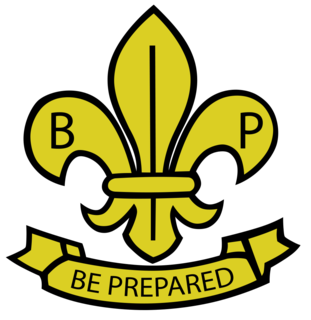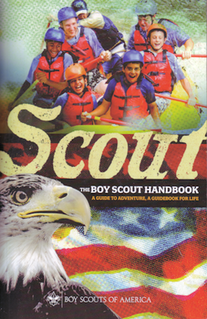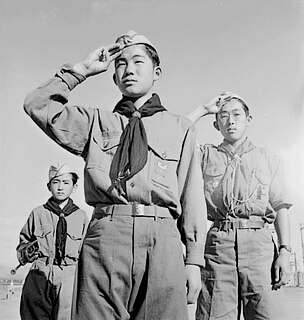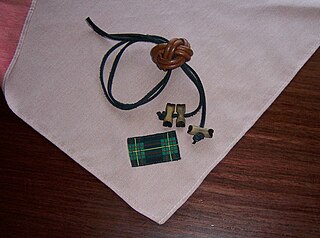
Baden-Powell's Scout training scheme was a progressive series of tests for Boy Scouts, in skills which the founder of the Scout Movement believed would be useful in building character and good citizenship.

Baden-Powell's Scout training scheme was a progressive series of tests for Boy Scouts, in skills which the founder of the Scout Movement believed would be useful in building character and good citizenship.
Robert Baden-Powell tested his ideas on boys' citizenship training in 1907 with an experimental camp on Brownsea Island, and in the following year, published Scouting for Boys in fortnightly instalments. Originally intended as a programme for leaders of other youth organisations to utilise, however independent Scout patrols were formed spontaneously across the United Kingdom. Baden-Powell's response was to establish a structured organisation, including tests for ranks which would enable boys to mark their proficiency in the various Scouting skills.

The Tenderfoot Test was the test that a boy, originally aged between 12 and 18 years old, would have to pass before he could make his Scout Promise and become an invested member of the Scout Troop. To become a Tenderfoot, a boy had to prove that he: knew the Scout Law and Promise, knew the Scout sign and salute, knew the composition of, and how to fly the Union Jack, and could tie six specified knots and knew their uses. The Tenderfoot Badge was the Scout fleur-de-lys emblem, embroidered on cloth and worn on the left pocket of the uniform shirt. A small brass badge was provided for wear in a lapel buttonhole when not in uniform. [1]
To become a Second Class Scout, a boy had to: have been a Tenderfoot for at least one month, have a knowledge of basic first aid and how to tie bandages, know the Semaphore or Morse code alphabet, follow a track for half a mile within 25 minutes, travel a mile using "Scout's pace" (alternate walking and running) in 12 minutes, build and light a camp fire using only two matches, cook meat and potatoes over an open fire, have at least sixpence in a bank account, and know the sixteen points of the compass. The Second Class Badge was a depiction of a scroll bearing the Scout motto, "Be Prepared". It was worn on the left upper sleeve. [2]

The tests for a First Class Scout were: swim 50 yards, send and receive a message in Semaphore or Morse at a specified rate of letters per minute, go on a fourteen-mile expedition over two days, by foot, boat or canoe and write a report on returning, know how to deal with a wide range of specified accidents and know the correct first aid techniques to use, using an open fire, know how to cook items from a list that included skinning a rabbit and gutting a fish, also be able to make "damper" (bread cooked in the embers of a fire), know map symbols, draw a sketch map and take a compass bearing, use an axe, estimate distances, area and capacity to within 25% error, and finally train another boy in the Tenderfoot skills so that he passes the test. The First Class Badge was a Scout emblem above the Second Class Badge. [3]
To become a King's Scout, a First Class Scout had to complete four proficiency badges from a specified list that covered core Scouting skills to a high standard. [4]

Scouting quickly spread to other countries and territories, both within the British Empire and outside of it. In these countries, Baden-Powell's scheme was adapted to suit local conditions. In the United Kingdom Boy Scouts' Association, there were several amendments to the scheme before it was replaced on the recommendation of the 1966 Advance Party Report, which said that "The worst condemnation of the present training Scheme is the fact that more than half of those who join the Movement never progress beyond the Tenderfoot stage". [5] The proposal for a new three stage scheme in which Scouts could progress rapidly in the early stages was adopted by the Association and began to be implemented in October 1967. [6] A number of Scout Groups that were dissatisfied with this and other restructuring formed the Baden-Powell Scouts' Association in 1970 and continue with an updated version of Baden-Powell's scheme to the present day. [7]
The training scheme of Scouts BSA, although thoroughly adapted and modernised, retains the structure of Tenderfoot, Second Class and First Class Scout devised by the founder. [8]

Scouting, also known as the Scout Movement, is a worldwide youth movement employing the Scout method, a program of informal education with an emphasis on practical outdoor activities, including camping, woodcraft, aquatics, hiking, backpacking, and sports. Another widely recognized movement characteristic is the Scout uniform, by intent hiding all differences of social standing in a country and making for equality, with neckerchief and campaign hat or comparable headwear. Distinctive uniform insignia include the fleur-de-lis and the trefoil, as well as merit badges and other patches.

A Scout is a child, usually 10–18 years of age, participating in the worldwide Scouting movement. Because of the large age and development span, many Scouting associations have split this age group into a junior and a senior section. Scouts are organized into troops averaging 20–30 Scouts under the guidance of one or more Scout Leaders or Scoutmasters. Troops subdivide into patrols of about 6–8 Scouts and engage in outdoor and special interest activities. Troops may affiliate with local, national, and international organizations. Some national Scouting associations have special interest programs such as Air Scouts, Sea Scouts, outdoor high adventure, Scouting bands, and rider Scouts.

The Baden-Powell Scouts' Association (B-PSA) is a worldwide youth organisation originating in the United Kingdom, with friendly relationships with similar traditional scouting organisations in various countries. Baden-Powell Scouting focuses on the importance of tradition in the scout movement.

Cub Scouts, Cubs or Wolf Cubs are programs associated with Scouting for young children usually between 7 and 12, depending on the organization to which they belong. A participant in the program is called a Cub. A group of Cubs is called a 'Pack'.

Boy Scout Handbook is the official handbook of Scouts BSA. It is a descendant of Baden-Powell's original handbook, Scouting for Boys, which has been the basis for Scout handbooks in many countries, with some variations to the text of the book depending on each country's codes and customs.

Rover Scouts, Rovers, Rover Scouting or Rovering is a program associated with some Scouting organizations for adult men and women. A group of Rovers is called a 'Rover Crew'.

William Hillcourt, known within the Scouting movement as "Green Bar Bill", was an influential leader in the Boy Scouts of America (BSA) organization from 1927 to 1992. Hillcourt was a prolific writer and teacher in the areas of woodcraft, troop and patrol structure, and training; his written works include three editions of the BSA's official Boy Scout Handbook, with over 12.6 million copies printed, other Scouting-related books and numerous magazine articles. Hillcourt developed and promoted the American adaptation of the Wood Badge adult Scout leader training program.
Traditional Scouting is "old-fashioned" or "back to basics" Scouting in some form, often with an emphasis on woodcraft and scoutcraft activities. As a decentralized movement, there is no one set definition for the term, but most groups do share a generally agreed-upon basic set of values and procedures. The Traditional Scouting movement aims to return Scouting to something approximating its original style and activities; rejecting the trend of modernizing the program in an attempt to widen its appeal.

The Scout method is the informal educational system used by Scouts. The aim of Scouting is character training with the goal of helping participants become independent and helpful, and thereby become "healthy, happy, helpful citizens".

Scouts BSA is the flagship membership level of the Boy Scouts of America (BSA) for boys and girls between the ages of typically 11 and 17. It provides youth training in character, citizenship, and mental and personal fitness. Scouts are expected to develop personal religious values, learn the principles of American heritage and government, and acquire skills to become successful adults.

Scouts, often referred to as the Scout section to differentiate itself from the wider movement and its parent organisation, is a section of Scouting run by The Scout Association for ten and a half to fourteen year old young people. The section follows on from Cub Scouts and precedes Explorer Scouts. Since 1991, the section has been coeducational and today the Scout section accepts young people from all backgrounds, faiths and genders.

The Wolf Cub's Handbook is an instructional handbook on Wolf Cubs training, published in various editions since December 1916. Early editions were written and illustrated by Robert Baden-Powell with later editions being extensively rewritten by others. The book has a theme based on Rudyard Kipling's The Jungle Book jungle setting and characters.
First Class Scout is a rank in the Boy Scouts of America, the rank above Second Class and below Star Scout. It is the highest of the lower four ranks in Scouting, and is the minimum rank that need be attained for entry into the Order of the Arrow.

The Pathfinder & Rover Explorer Scouts' Association (P-RESA) is an independent Traditional Scouting Association in the United Kingdom, with International branches. The Association's training programme runs along the lines of Baden-Powell's original Scouting for Boys, upholding the traditions and practices set out by B-P, using the 1938 Boy Scouts' Association Policy Organisation & Rules (POR) as its basis.

The Boy Scouts of America (BSA) was inspired by and modeled on The Boy Scouts Association, established by Robert Baden-Powell in Britain in 1910. In the early 1900s, several youth organizations were active, and many became part of the BSA.

The advancement program for Scouts participating in the Scouts BSA program of the Boy Scouts of America is symbolized by the earning of seven ranks. The advancement program is often considered to be divided into two phases. The first phase from joining to First Class is designed to teach the scout Scoutcraft skills, how to participate in a group and to learn self-reliance. The Scout badge is awarded when the Scout demonstrates a rudimentary knowledge of the Scouting ideals and program. Tenderfoot, Second Class, and First Class have progressively harder requirements in the areas of Scoutcraft, physical fitness, citizenship, personal growth and Scout Spirit.

The White Stag Leadership Development Program, founded in 1958, is a summer leadership training program for youth 10 1/2–18 led by two California-based non-profits that sponsor leadership development activities. The teen youth staff of the two programs develop and produce several week-long leadership summer training sessions every year for several hundred youth from Central and Northern California and a few youth from other states and countries. The outdoors program is based on hands-on learning methods to develop competencies.

Wood Badge in the United States is the highest level of adult Scout leader training available. The first Wood Badge course was presented in England by the founder of Scouting, Baden-Powell, and he introduced the program into the United States during a visit in 1936. The first course was held at the Mortimer L. Schiff Scout Reservation, but Americans did not fully adopt Wood Badge until 1948. The National BSA Council staff provided direct leadership to the program through 1958, when the increased demand encouraged them to permit local councils to deliver the training.
As with Scouts in The Scout Association, the Scout section of the BPSA is the direct descendant of the original Scout Patrols which formed in the United Kingdom in 1908. The section is open to both boys and girls between the ages of 10–15 years, and are now formed into local Scout Troops.

A Scout staff is a shoulder-high wooden pole or quarterstaff, traditionally carried by Boy Scouts as part of their accoutrements. Its main purpose was as a walking stick or Trekking pole, but it had a number of other uses in emergency situations and can be used for Scout pioneering.